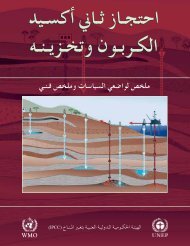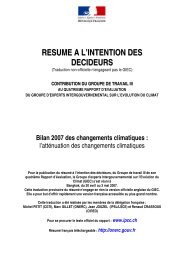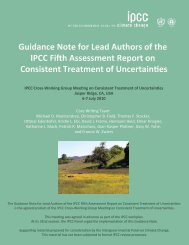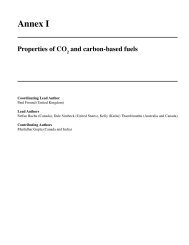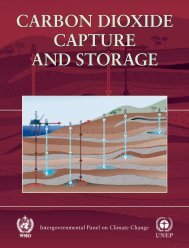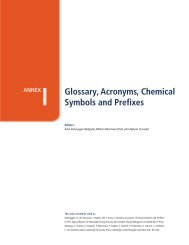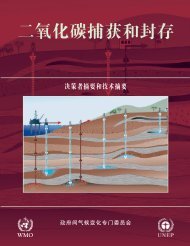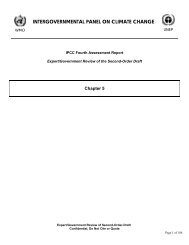SODBatch A&B SPM Comments co-chair response final ... - ipcc-wg3
SODBatch A&B SPM Comments co-chair response final ... - ipcc-wg3
SODBatch A&B SPM Comments co-chair response final ... - ipcc-wg3
Create successful ePaper yourself
Turn your PDF publications into a flip-book with our unique Google optimized e-Paper software.
Chapter-<br />
Comment<br />
<strong>SPM</strong>-<br />
645<br />
<strong>SPM</strong>-<br />
646<br />
<strong>SPM</strong>-<br />
647<br />
para<br />
9h<br />
ea<br />
di<br />
ng<br />
9h<br />
ea<br />
di<br />
ng<br />
9h<br />
ea<br />
di<br />
ng<br />
Batch<br />
From Page<br />
From Line<br />
To Page<br />
To line<br />
<strong>Comments</strong><br />
IPCC WGIII Fourth Assessment Report, Se<strong>co</strong>nd Order Draft<br />
that the low <strong>co</strong>sts options of statement 9".<br />
(Rob Swart, MNP)<br />
A 9 1 9 5 the statement that there is “a large low-<strong>co</strong>st mitigation potential”<br />
needs to be qualified in light of the potentially large double<strong>co</strong>unting<br />
problem that I have raised in my “General <strong>Comments</strong>”<br />
above. Furthermore, why, if <strong>co</strong>st is so “low”, is it difficult to get<br />
governments to implement policies that would achieve mitigation<br />
potential? Indeed, why, if <strong>co</strong>st is so low, is government policy<br />
needed at all? Perhaps the answer is that <strong>co</strong>st is not low, once<br />
limited scalability of current technologies or lack of enabling<br />
technologies (e.g., storage for intermittent solar and wind) are<br />
<strong>co</strong>nsidered.<br />
(Christopher Green, McGill University)<br />
A 9 1 9 5 The paragraph begins talking about the "large low-<strong>co</strong>st mitigation<br />
potential between now and 2030 in the various sectors"; then refers<br />
to "more <strong>co</strong>stly measures" needed "to be on a trajectory towards<br />
stabilisation at 450 to 550 ppmvCO2-eq", although their impact on<br />
"annual GDPgrowth rates is limited". And finishes referring to the<br />
need of "appropriate additional government policies" for achieving<br />
"this potential"; but which potential refers to? The low-<strong>co</strong>st<br />
measures, or the more <strong>co</strong>stly ones? At least for me, it is not very<br />
clear, or isn't clear at all.<br />
(JULIO TORRES-MARTINEZ, Cuban Observatory for Science<br />
and Technology)<br />
A 9 1 5 5 Again, this paragraph seems to be re<strong>co</strong>mmending a stabilization<br />
level around 450 and 550 ppmv CO2 emissions, while the literature<br />
on stablization of GHGs <strong>co</strong>ncentrations indicate the possibility of<br />
reaching levels as low as 375 ppmv CO2. We re<strong>co</strong>mmend to<br />
replace the current text at line two with the following text: 'To be<br />
on a trajectory towards stabilization at 375 and 400 ppmv<br />
requires...'<br />
Expert Review of Se<strong>co</strong>nd-Order-Draft<br />
Confidential, Do Not Cite or Quote<br />
Response suggested by <strong>co</strong><strong>chair</strong>s<br />
TIA when merging section C<br />
header with para 9<br />
Avoid “low”<br />
Argument that low <strong>co</strong>st<br />
measures do not need policy<br />
intervention is not <strong>co</strong>rrect: there<br />
are strong barriers; this needs to<br />
be said explicitly, where<br />
negative <strong>co</strong>sts are mentioned<br />
TIA when merging section C<br />
header with para 9<br />
REJ; that is not what the text<br />
says<br />
Action<br />
for<br />
chapter<br />
Considerations<br />
by the writing<br />
team<br />
Check price<br />
range statement<br />
26 with text<br />
ch11.<br />
(11)<br />
TIA in above<br />
<strong>co</strong>mment.<br />
(11)<br />
TIA.<br />
(11)<br />
Agree<br />
(11)<br />
Page 166 of 348



